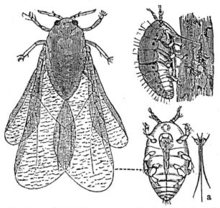https://en.m.wikipedia.org/wiki/Phylloxera
vrijdag 7 april 2023
zondag 21 maart 2021
woensdag 3 februari 2021
The evolution of plants; a natural force for well-being
The evolution of plants; a natural force for well-being
Botanical research published in the scientific journal Nature Ecology and Evolution shows how the diversity of benefits that plants provide to humans is the result of evolutionary processes that encompass the entire plant Tree of Life.
The history of human civilizations could not be understood without the plants that have contributed to our well-being so much. Besides many other benefits, we have used them for healing, clothing, feeding, and warming ourselves, building and decorating our homes, and even to convey our feelings. As with everything related to biodiversity, these plant services are nothing more than the result of evolution. For example, the pressure exerted by herbivorous insects on plants has driven the evolution of chemical defences, molecules that form the basis of many insecticides. Other species accumulate reserves that we humans use for our own food, and many of them have extraordinarily eye-catching and fragrant flowers that attract pollinators and gardeners alike. One could say that biological evolution is in effect a force for human good.
The close relationship between the evolutionary history of plants and their benefits to humans has inspired research led by Dr Molina-Venegas from the University of Alcalá (Spain), which suggests that humans have scoured the entirety of the evolutionary tree of plants (i.e. their entire evolutionary history) in search of the botanical benefits that underpin our well-being.
The authors of the study compiled from the latest edition of Mabberley’s Plant-book (Cambridge University Press, 2017) an extensive database of global plant uses, according to 28 categories related to human and livestock nutrition, fuels, materials, medicines, poisons, social and environmental uses. This analysis enabled the authors to conclude that, in general, selecting plants that have widely different evolutionary histories captures a greater number and diversity of benefits than does a strategy based on random sampling or one limited to prospecting solely close relatives. This can be explained by the fact that plant attributes that benefit humans have evolved throughout the plant Tree of Life.
Although the theoretical foundations of such research were formalized in the early 1990s, recent studies have demonstrated that the empirical evidence supporting the theory was still tenuous, and so even questioned its reliability. In supporting the theory, the work led by Dr Molina-Venegas contributes to filling a gap of knowledge that has fueled intense scientific debate in recent years. The conclusion is now clear: taking into account the evolutionary history of species when setting conservation priorities could be the key to ensuring the maximum beneficial potential of biodiversity for the future of humanity.
Brief biographical sketch of the author:
Rafael graduated in biology at the University of Seville, where he completed his PhD on the evolutionary history of plants in the Baetic-Rifan biodiversity hotspot (Andalusia and Northern Morocco). After postdoctoral studies at the University of Alcalá, he moved to the Institute of Plant Science at the University of Bern (Switzerland), where he investigated the relationship between humans and plant benefits from an evolutionary perspective. In 2019, he returned to the University of Alcalá where he is currently leading his own research project, aimed at exploring connections between plant evolutionary history and human well-being.
For correspondence:contact formulary at https://rafmolven.wixsite.com/rafmolven/contact-me
zaterdag 9 januari 2021
How did the cranberries arrive in the Netherlands?
A friendly lady from "Dr. Vogel" explained to me that their hand picked berries came from Denmark. However, later she discovered they import them from New Jersey.
In New Jersey they also use the dry harvesting method. This farmer explains he prefers this method,since it is healthier for his plants not to "drown" them every year.Eventually that is much better for the quality of the fruits.https://theproducenews.com/sunny-valley-expects-high-quality-new-jersey-cranberry-program.
In the Netherlands they also harvest cranberries.No one knows how they got there:
Probably in 1845 a beachcomber found a barrel. He did not like the sour berries, and threw them in the dunes.All caught by the Terschellinger Webcam 😜
https://nl.wikipedia.org/wiki/Cranberry
No, I think they created this movie for the "Terschellinger Cranberies" Company: https://terschellingercranberries.nl/cranberries/geschiedenis/
The berries were found by Holkema in 1868.
Since Holkema died of tuberculosis, before finishing his book. Professor van Hall finished it for him:
https://nl.wikipedia.org/wiki/Herman_Christiaan_van_Hall
dinsdag 5 januari 2021
Ericaceae, Cranberries, Harvesting
Cranberries are harvested by flooding he fields. A cranberry has 4 air pockets, so they can float!
After the flooding, the "Egg Beater" passes by to loosen the berries from the vines.
This method is widely used in New Jersey.
Dry harvesting is also used. This farmer explains he uses the dry harvesting, because it keeps his plants healthier and stronger, which results in High Quality Berries.
https://theproducenews.com/sunny-valley-expects-high-quality-new-jersey-cranberry-program
zaterdag 2 januari 2021
Ericaceae, heidefamilie
De heidefamilie (Ericaceae) is een familie van bedektzadige veelal houtige maar ook kruidachtige planten. De familie komt wereldwijd voor, maar zelden in tropisch laagland.
https://en.wikipedia.org/wiki/Ericaceae


